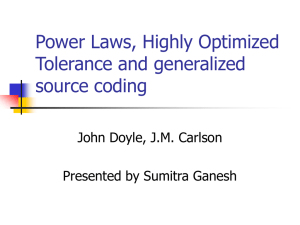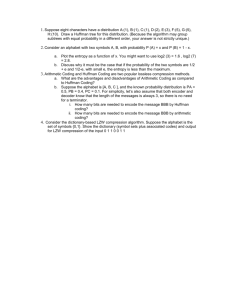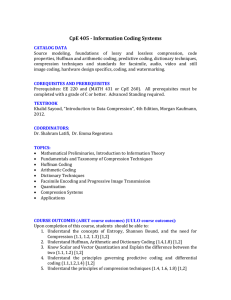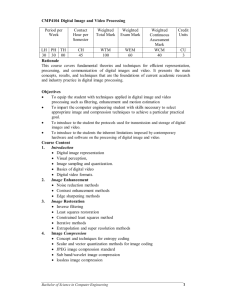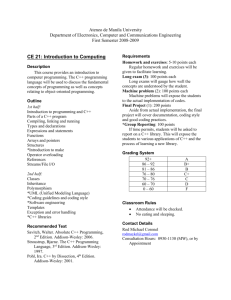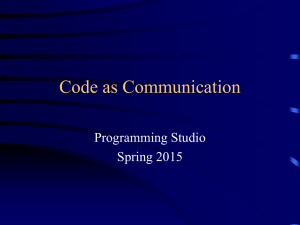Image and Video Compression Lecture 12, April 27 , 2009 Lexing Xie
advertisement
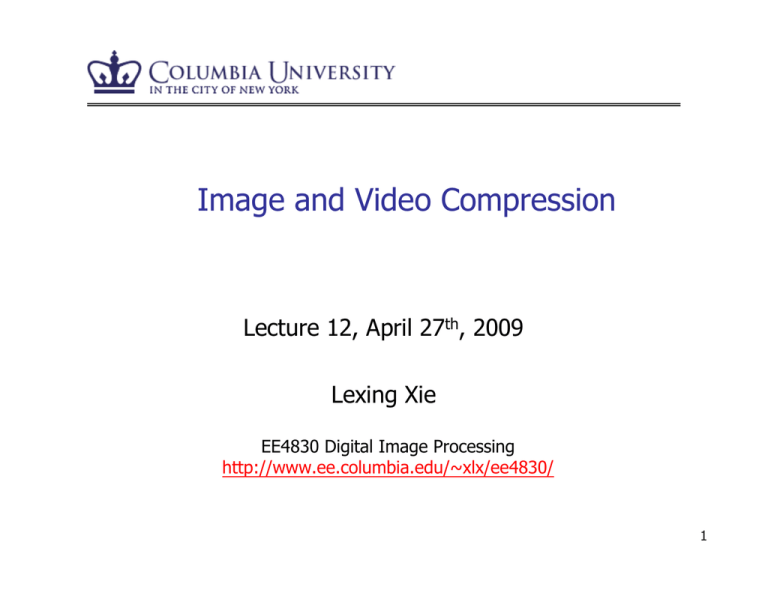
Image and Video Compression
Lecture 12, April 27th, 2009
Lexing Xie
EE4830 Digital Image Processing
http://www.ee.columbia.edu/~xlx/ee4830/
1
Announcements
Evaluations on CourseWorks
please fill in and let us know what you think ☺
Reminder for HW#6
you can choose between doing by hand or simple
programming for problem 1 and problem 3
Problem 4 and 5 are optionally due next Wednesday
May 6th
2
outline
image/video compression: what and why
source coding basics
compression systems and standards
basic idea
symbol codes
stream codes
system standards and quality measures
image coding JPEG
video coding and MPEG
audio coding (mp3) vs. image coding
summary
3
the need for compression
Image: 6.0 million pixel camera, 3000x2000
18 MB per image 56 pictures / 1GB
Video: DVD Disc 4.7 GB
video 720x480, RGB, 30 f/s 31.1MB/sec
audio 16bits x 44.1KHz stereo 176.4KB/s
1.5 min per DVD disc
Send video from cellphone:
352*240, RGB, 15 frames / second
3.8 MB/sec $38.00/sec levied by AT&T
4
Data Compression
Wikipedia: “data compression, or source coding, is the process of
encoding information using fewer bits (or other information-bearing
units) than an unencoded representation would use through use of
specific encoding schemes.”
Applications
General data compression: .zip, .gz …
Image over network: telephone/internet/wireless/etc
Slow device:
1xCD-ROM 150KB/s, bluetooth v1.2 up to ~0.25MB/s
Large multimedia databases
Understanding compression:
what are behind jpeg/mpeg/mp4 … formats?
what are the “good/fine/super fine” quality modifiers in my Canon 400D?
why/when do I want to use raw/jpeg format in my digital camera?
why doesn’t “zipping” jpeg files help?
what are the best ways to do compression?
are we doing our best? (yes/no/maybe)
5
what can we compress?
Goals of compression
Remove redundancy
Reduce irrelevance
irrelevance or perceptual redundancy
not all visual information is perceived by eye/brain,
so throw away those that are not.
6
what can we compress?
Goals of compression
Remove redundancy
Reduce irrelevance
redundant : exceeding what is
necessary or normal
symbol redundancy
the common and uncommon values
cost the same to store
spatial and temporal redundancy
Temperatures: tend to be similar in
adjacent geographical areas, also tend
to be similar in the same month over
different years …
7
symbol/inter-symbol redundancy
Letters and words in
English
e, a, i, s, t, …
q, y, z, x, j, …
a, the, me, I …
good, magnificent, …
fyi, btw, ttyl …
In the evolution of
language we naturally
chose to represent frequent
meanings with shorter
representations.
8
redundancy in an image
Symbol redundancy in
an image:
Some gray level value
are more probable than
others.
Spatial redundancy:
Pixel values are not
i.i.d.
9
modes of compression
Lossless
preserve all information, perfectly recoverable
examples: morse code, zip/gz
Lossy
throw away perceptually insignificant information
cannot recover all bits
10
how much can we compress a picture?
same dimensions (1600x1200), same
original representation -- 3 bytes/pixel,
5.76MB uncompressed, same compressed
representation (JPEG), same viewer
sensitivity and subjective quality …
different “information content” in each
image!
11
characterizing information
i.i.d. random variable x
information content
12
characterize the surprising-ness
related to probability
additive for independent variables.
explanations
cross-words: how many words have you
“ruled out” after knowing that a word starts
with an “a” or with a “z” ?
#”a*” 35,174 words
#“z*” 1,718 words
English vocabulary: ~500K words
FindTheWord.info
information content and entropy
Shannon information content
additive for independent variables:
Entropy: expected information content
13
source coding
source code
length of a codeword
expected length of a code
an example
14
15
source coding theorem
informal shorthand:
[Shannon 1948]
revisiting Morse code
16
Left as excercise
desired properties of symbol codes
good codes are not only short but also easy to
encode/decode
Non-singular: every symbol in X maps to a different code word
Uniquely decodable: every sequence {x1, … xn} maps to
different codeword sequence
Instantaneous: no codeword is a prefix of any other codeword
English in less than 26 letters (just kidding)
The European Union commissioners have announced that agreement has been reached to adopt English as the
preferred language for European communications, rather than German, which was the other possibility. As part
of the negotiations, Her Majesty's Government conceded that English spelling had some room for improvement
and has accepted a five-year phased plan for what will be known as Euro-English (Euro for short).
In the first year, 's' will be used instead of the soft 'c'. Sertainly, sivil servants will resieve this news with joy.
Also, the hard 'c' will be replaced with 'k.' Not only will this klear up konfusion, but typewriters kan have one
less letter.
There will be growing publik enthusiasm in the sekond year, when the troublesome 'ph' will be replaced by 'f'.
This will make words like 'fotograf' 20 per sent shorter.
In the third year, publik akseptanse of the new spelling kan be expekted to reach the stage where more
komplikated changes are possible. Governments will enkourage the removal of double letters, which have
always ben a deterent to akurate speling. Also, al wil agre that the horible mes of silent 'e's in the languag is
disgrasful, and they would go.
By the fourth year, peopl wil be reseptiv to steps such as replasing 'th' by 'z' and 'W' by 'V'. During ze fifz year,
ze unesesary 'o' kan be dropd from vords kontaining 'ou', and similar changes vud of kors; be aplid to ozer
kombinations of leters.
After zis fifz yer, ve vil hav a reli sensibl riten styl. Zer vil b no mor trubls or difikultis and evrivun vil find it ezi
tu understand ech ozer. Ze drem vil finali kum tru.
17
desired properties of symbol codes
Non-singular: every symbol in X maps to a different code word
Uniquely decodable: every sequence {x1, … xn} maps to
different codeword sequence
Instantaneous: no codeword is a prefix of any other codeword
Morse code without blanks:
EAH
IDI
··−····
18
desired properties of symbol codes
Non-singular: every symbol in X maps to a different code word
Uniquely decodable: every sequence {x1, … xn} maps to
different codeword sequence
Instantaneous: no codeword is a prefix of any other codeword
a.k.a. prefix code, self-punctuating code, prefix-free code.
non-singular uniquely decodable
instantaneous
19
20
good news: being unique decodable + instantaneous
do not compromise coding efficiency (much)
Huffman codes
optimal symbol code by construction
21
22
construct Huffman codes
a recursive algorithm in two steps
Example 1
Code created by
greedy top-down splits
00
01
10
110
111
H(X)=2.2855, L(C) = 2.30
We have H(X) <= L(C) <= H(X)+1
Greedy division can be suboptimal
example 2
23
24
why do we need stream codes
Huffman code is optimal but must be integer length.
each symbol x codeword c(x)
the interval [H(X), H(X)+1) can be loose.
consider the following optimal symbol code:
Stream code: mapping a stream of symbols
X: x1x2, …, xn codeword c(X)
25
arithmetic coding
26
Observation #1: Symbol distributions split the [0,1) into intervals.
Observation #2: interval division can be recursive.
Arithmetic coding can treats the whole message as one unit.
A message is represented by a half-open interval [a; b) where a and b are real
numbers between 0 and 1. Initially, the interval is [0; 1). When the message
becomes longer, the length of the interval shortens and the number of bits needed to
represent the interval increases.
Arithmetic Encoding Agorithm
BEGIN
low = 0.0; high = 1.0; range = 1.0;
while (symbol != terminator)
{
get (symbol);
low = low + range * Range_low(symbol);
high = low + range * Range_high(symbol);
range = high - low;
}
output a code so that low <= code < high;
END
low
high
range
0.0
1.0
1.0
0.0
0.2
0.2
0.04
0.08
0.04
0.056
0.072
0.016
Rissanen, Jorma (May 1976).
"Generalized Kraft Inequality and
Arithmetic Coding" (PDF). IBM
Journal of Research and
Development 20 (3): 198–203..
universal data compression
28
What if the symbol probabilities are unknown?
LZW algorithm (Lempel-Ziv-Welch)
encoding
decoding
w = NIL;
while ( read a character k )
{
if wk exists in the dictionary
w = wk;
else
add wk to the dictionary;
output the code for w;
w = k;
}
read a character k;
output k;
w = k;
while ( read a character k )
/* k could be a character or a code. */
{
entry = dictionary entry for k;
output entry;
add w + entry[0] to dictionary;
w = entry;
}
Widely used: GIF, TIFF, PDF …
Its royalty-free variant (DEFLATE) used in PNG, ZIP, …
Unisys U.S. LZW Patent No. 4,558,302 expired on June 20,
2003 http://www.unisys.com/about__unisys/lzw
LZW
Example
39
39
39
39
39
39
39
39
126
126
126
126
126
126
126
126
Exercise: verify that the dictionary can be automatically
reconstructed during decoding. (G&W Problem 8.20)
29
30
Run-Length Coding
Encode the number of consecutive ‘0’s or ‘1’s
Used in FAX transmission standard
Why is run-length coding with
p = P(X=0) >> P(X=1) actually beneficial?
See Jain Sec 11.3 (at courseworks)
probability of a run
average run-length
compression ratio
e.g.
p=0.9
M=15
µ=7.94
C=1.985
Predictive Coding
Signals are correlated predict and encoding the difference lowers
the bitrate
Good prediction is the key: e.g. LPC (linear-predctive) speech coding
31
outline
image/video compression: what and why
source coding basics
compression systems and standards
basic idea
symbol codes
stream codes
system standards and quality measures
image coding and JPEG
video coding and MPEG
audio coding (mp3) vs. image coding
summary
32
33
measuring image quality
Quality measures
PSNR (Peak-Signal-to-Noise-Ratio)
Why would we prefer PSNR over SNR?
Visual quality
PSNR = 10 log10
1
MN
Compression Artifacts
Subjective rating scale
255
2
| f ′( x, y ) − f ( x, y ) |
∑
xy
2
34
measuring coding systems
End-to-end measures of source
coding system: Rate-Distortion
PSNR (DB)
Other considerations
Computational complexity
Power consumption
Memory requirement
Delay
Error resilience/sensitivity
bit rate
bpp: bit-per-pixel;
Kbps: Kilo-bits-per-second
Subjective quality
Image/Video Compression Standards
Bitstream useful only if the recipient knows the code!
Standardization efforts are important
35
Technology and algorithm benchmark
System definition and development
Patent pool management
Defines the bitstream (decoder), not how you generate them (encoder)!
36
current industry focus:
H.264 encoding/decoding on mobile devices,
low-latency video transmission over various networks,
low-power video codec …
37
block-based transform coding systems
Review: properties of unitary transforms/DCT
De-correlation: highly correlated input elements quite
uncorrelated output coefficients
Energy compaction: many common transforms tend to pack a large
fraction of signal energy into just a few transform coefficients
Symbol coding/decoding
predictive coding
run-length coding
Huffman codes
adaptive arithmetic coding …
38
JPEG compression standard (early 1990s)
JPEG - Joint Photographic Experts Group
Compression standard of generic continuous-tone still image
Became an international standard in 1992
Allow for lossy and lossless encoding of still images
Part-1 DCT-based lossy compression
average compression ratio 15:1
Part-2 Predictive-based lossless compression
Sequential, Progressive, Hierarchical modes
Sequential: encoded in a single left-to-right, top-to-bottom scan
Progressive: encoded in multiple scans to first produce a quick,
rough decoded image when the transmission time is long
Hierarchical: encoded at multiple resolution to allow accessing low
resolution without full decompression
39
40
color representation in JPG
R
G
B
41
color representation in JPG
Y-luminance
Cb
assign more bits to Y, less bits to Cb and Cr
Cr
baseline JPEG algorithm
“Baseline”
Simple, lossy compression
42
Subset of other DCT-based modes of JPEG standard
A few basics
8x8 block-DCT based coding
Shift to zero-mean by subtracting 128 [-128, 127]
Color (YCbCr / YUV) and downsample
Allows using signed integer to represent both DC and AC coeff.
Color components can have lower
spatial resolution than luminance
Interleaving color components
Y 0 . 299
C = − 0 . 147
b
C r 0 . 615
0 . 587
− 0 . 289
− 0 . 515
0 . 114
0 . 436
− 0 . 100
R
G
B
(Based on Wang’s video book Chapt.1)
block-based transform
Review: why transform?
Compacting energy
Data de-correlation
Why block based?
High transform computation
complexity for larger blocks
43
complexit
y
O( m log m × m ) per block
in transform for (MN/m2) blocks
High complexity in bit allocation
Block transform captures local info
Commonly used block sizes: 8x8,
16x16, 8x4, 4x8 …
From Jain’s Fig.11.16
zonal coding and threshold coding
Zonal coding
Threshold coding
Only transmit a small predetermined zone of transformed
coeff.
Transmit coeff. that are above certain thresholds
Compare
Threshold coding is inherently adaptive
introduce smaller distortion for the same number of coded coeff.
Threshold coding needs overhead in specifying index of
coded coeff.
run-length coding helps to reduce overhead
44
45
perform quantization
Input:
The quantizer output is:
I(u,v)=Round[X(u,v)/Q(u,v)]
8x8 DCT image X(u,v)
Quantization table Q(u,v)
“round” is to the nearest
integer
JPEG default luminance table
shown on the right
Smaller Q(u,v) means a smaller
step size and hence more
resolution, vice-versa
Q(u,v) may be scaled by a
quality factor
16
11
10
16
24
40
51
61
12
12
14
19
26
58
60
55
14
13
16
24
40
57
69
56
14
17
22
29
51
87
80
62
18
22
37
56
68
109
103
77
24
35
55
64
81
104
113
92
49
64
78
87
103
121
120
101
72
92
95
98
112
100
103
99
quantization of transform coefficients
Default quantization table
“Generic” over a variety of images
Adaptive Quantization (bit allocation)
Different quantization step size for different coeff. bands
Use same quantization matrix for all blocks in one image
Choose quantization matrix to best suit the image
Different quantization matrices for luminance and color
components
Quality factor “Q”
Scale the quantization table
Medium quality Q = 50% ~ no scaling
High quality Q = 100% ~ unit quantization step size
Poor quality ~ small Q, larger quantization step
visible artifacts like ringing and blockiness
46
encode an image block
Basic tools
47
Run-length coding
Predictive coding (esp. for DC coefficient)
Entropy coding (Huffman, etc.)
Scan order
zig-zag scan for block-DCT to better achieve run-length
coding gain AC
DC
Vertical
frequency
AC70
01
Horizontal frequency
AC07
⇒ low-frequency coefficients,
then high frequency coefficients
AC77
encoding a block in JPEG
Differentially encode DC (and quantize)
( SIZE, AMPLITUDE ), with amplitude range in [-2048, 2047]
AC coefficients in one block
Zig-zag scan after quantization for better run-length
save bits in coding consecutive zeros
Represent each AC run-length using entropy coding
use shorter codes for more likely AC run-length symbols
Symbol-1: ( RUNLENGTH, SIZE ) Huffman coded
Symbol-2: AMPLITUDE Variable length coded
RUNLENGTH ∈ [0,15]
# of consecutive zero-valued AC coefficients
preceding the nonzero AC coefficient ∈ [0,15]
SIZE ∈ [0 to 10 in unit of bits]
# of bits used to encode AMPLITUDE
AMPLITUDE ∈ in range of [-1023, 1024]
48
49
Uncompressed (100KB)
JPEG 75% (18KB)
JPEG 50% (12KB)
JPEG 30% (9KB)
JPEG 10% (5KB)
JPEG Compression (Q=96, 75 & 25)
644 KB
239 KB
55 KB
50
JPEG 2000
Better image quality/coding efficiency, esp. low bit-rate
compression performance
DWT
Bit-plane coding (EBCOT)
Flexible block sizes
…
More functionality
Support larger images
Progressive transmission by quality, resolution, component, or
spatial locality
Lossy and Lossless compression
Random access to the bitstream
Region of Interest coding
Robustness to bit errors
51
Video ?= Motion Pictures
Capturing video
Frame by frame => image sequence
Image sequence: A 3-D signal
2 spatial dimensions & time dimension
continuous I( x, y, t ) => discrete I( m, n, tk )
Encode digital video
Simplest way ~ compress each frame image individually
e.g., “motion-JPEG”
only spatial redundancy is explored and reduced
How about temporal redundancy? Is differential coding good?
Pixel-by-pixel difference could still be large due to motion
Need better prediction
52
hybrid video coding system
mux
demux
53
Block partition in video coding systems
Work on each macroblock (MB) (16x16 pixels)
independently for reduced complexity
Motion compensation done at the MB level
DCT coding at the block level (8x8 pixels)
54
representing motion
Predict a new frame from a previous frame and only code the
prediction error --- Inter prediction on “B” and “P” frames
Predict a current block from previously coded blocks in the same
frame --- Intra prediction (introduced in the latest standard H.264)
Prediction errors have smaller energy than the original pixel values
and can be coded with fewer bits
DCT on the prediction errors
Those regions that cannot be predicted well will be coded directly
using DCT --- Intra coding without intra-prediction
55
(From Princeton EE330 S’01 by B.Liu)
56
“Horse ride”
Motion estimation
Pixel-wise difference w/o motion compensation
Residue after motion compensation
Revised from R.Liu Seminar Course ’00 @ UMD
motion compensation
Help reduce temporal redundancy of video
PREVIOUS FRAME
CURRENT FRAME
PREDICTED FRAME
PREDICTION ERROR FRAME
57
motion estimation
Help understanding the content of image sequence
Help reduce temporal redundancy of video
For compression
Stabilizing video by detecting and removing small, noisy
global motions
For building stabilizer in camcorder
A hard problem in general!
58
block-matching with exhaustive search
59
Assume block-based translation motion model
Search every possibility over a specified range for the best
matching block
MAD (mean absolute difference) often used for simplicity
From Wang’s
Preprint Fig.6.6
audio coding versus image coding
Data Unit
MP3 (wideband
audio coding)
Frame
JPEG
Block
Transform
MDCT
DCT
Quantization
Fixed Quantization
matrix base on
psychoacoustic
masking
Baseline
quantization matrix
+ adaptive rate
control
Entropy coding
Huffman code
Huffman code,
run-length,
differential
60
VC demo
61
Revisiting Our Questions
what are behind jpeg/mpeg/mp4 … formats?
what are the “good/fine/super fine” in my Canon
Powershot?
why/when do I want to use raw/jpeg format in my
Nikon D80?
why doesn’t “zipping” jpeg files help?
Do JPEG/MPEG compression algorithms remove
perceptual redundancy, symbol redundancy, and
spatial/temporal redundancy, how?
what are the best ways to do compression?
are we doing our best? (yes/no/maybe)
Recent Activities in Image Compression
Build better, more versatile systems
In search for better basis
High-definition IPTV
Wireless and embedded applications
P2P video delivery
Curvelets, contourlets, …
“compressed sensing”
64
Summary
The image/video compression problem
Source coding
Image/video compression systems
transform coding system for images
hybrid coding system for video
Readings
entropy, source coding theorem, criteria for good codes, huffman
coding, stream codes and code for symbol sequences
G&W 8.1-8.2 (exclude 8.2.2)
McKay book chapter 1, 5
http://www.inference.phy.cam.ac.uk/mackay/itila/
Next time: reconstruction in medical imaging and
multimedia indexing and retrieval
material sources: David McKay’s book, Min Wu (UMD), Yao Wang (poly tech), …
65
66
http://www.flickr.com/photos/jmhouse/2250089958/
jpeg 2000 supplemental slides
67
Wavelets
A wavelet is a square integrable function whose
translates and dilates form an orthonormal basis for
Hilbert space L2(RN).
Theory
Algebra, Geometry
Analysis (mainly studying functions and operators)
Fourier, Harmonic, Wavelets
68
JPEG-2000 V.S. JPEG
(a)
(b)
Compression at 0.25 b/p by means of (a) JPEG (b) JPEG-2000
69
JPEG-2000 V.S. JPEG
(a)
(b)
Compression at 0.2 b/p by means of (a) JPEG (b) JPEG-2000
70
71
The trade-off:
JPEG2000 has a much Higher computational complexity than JPEG,
especially for larger pictures.
Need parallel
implementation
to reduce
compression
time.
motion estimation supplemental slides
72
Fractional Accuracy Search for Block Matching
For motion accuracy of 1/K pixel
Upsample (interpolate) reference frame by a factor of K
Search for the best matching block in the upsampled reference
frame
Half-pel accuracy ~ K=2
Significant accuracy improvement over integer-pel
(esp. for low-resolution)
Complexity increase
(From Wang’s Preprint Fig.6.7)
73
Complexity of Exhaustive Block-Matching
Assumptions
Block size NxN and image size S=M1xM2
Search step size is 1 pixel ~ “integer-pel accuracy”
Search range +/–R pixels both horizontally and vertically
Computation complexity
2
# Candidate matching blocks = (2R+1)
2
# Operations for computing MAD for one block ~ O(N )
2 2
# Operations for MV estimation per block ~ O((2R+1) N )
2
# Blocks = S / N
2
Total # operations for entire frame ~ O((2R+1) S)
i.e., overall computation load is independent of block size!
E.g., M=512, N=16, R=16, 30fps
=> On the order of 8.55 x 109 operations per second!
Was difficult for real time estimation, but possible with parallel
hardware
74
UMCP ENEE408G Slides (created by M.Wu & R.Liu © 2002)
Exhaustive Search: Cons and Pros
Pros
Guaranteed optimality within search range and motion model
Cons
Can only search among finitely many candidates
What if the motion is “fractional”?
High computation complexity
On the order of [search-range-size * image-size] for 1-pixel step size
How to improve accuracy?
Include blocks at fractional translation as candidates
=> require interpolation
How to improve speed?
Try to exclude unlikely candidates
75
Fast Algorithms for Block Matching
76
Basic ideas
Matching errors near the best match are generally smaller
than far away
Skip candidates that are unlikely to give good match
(From Wang’s Preprint Fig.6.6)
motion vector
77
{dx, dy} = {1, 6}
Fast Algorithm: 3-Step Search
dy
Search candidates at 8
neighbor positions
Step-size cut down by
2 after each iteration
Start with step size
approx. half of max.
-6
search range
Total number of computations:
9 + 8×2 = 25 (3-step)
(2R+1)2 = 169 (full search)
M24
M15
M14
M13
M11
M16
M5
M4
M6
M7
M8
M12
M3
M17
M18
M1
M2
M19
dx
+6
M9
(Fig. from Ken Lam – HK Poly Univ.
short course in summer’2001)
